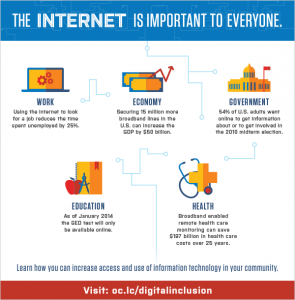When we think of internet access, or wait do we actually think of that at all. Because I work in a low-income school district, I am more aware than I used to be regarding the disparity of access amongst my students.
The Broadband Availability Gap research is a real eye opener when we start to look beyond the advertisements for the next whammy dine service available. Though a heady piece of research, for those of us that are data-driven, it may just change previous assumptions.
The Pew Research Center is a nonpartisan fact tank that informs the public about the issues, attitudes and trends shaping America and the world. It is a site worth exploring and in my case, I will return often for updates and trends. Technology is only one of dozens of topics, check it out.
According to Digital Differences research conducted by Pew, differences in internet access still exist among various demographic groups, especially among high-speed broadband access at home. 1 in 5 Americans does not use the internet. Some of the factors that influence a lack of internet use include:
- Lower Income – Below 30K
- Lower education rates
- Age – specifically senior citizens
- Citizens with disabilities
Cost and relevance are the primary reasons cited for nonuse.
Cord Cutters
More people are connecting via smartphone and cutting the cord to broadband commitment at home. Though this may result in lower bills, it comes at a price. According to Pew data, among smartphone owners, young adults, minorities, those with no college experience, and those with lower household income levels are more likely than other groups to say that their phone is their main source of internet access. Device only users are more likely than others to run up against:
- Data-cap limits
- Canceled or suspended service
- Challenge when filling out applications and other forms
- Limited visual quality
Those without home high-speed service face a major disadvantage when it comes to accessing government services, searching for employment, following the news, learning new things, or getting health information.
Suffice to say, the internet is important to everyone and some people are getting left behind.
How Can We Increase Digital Inclusion?
Technology and internet access strategies for individuals include (but are not limited to!):
- Public access computers.
- Computers accessible to defined populations (such as residents of a housing complex).
- Free wifi hotspots.
- Low-cost options for home computer purchasing.
- Partnering with broadband providers to offer low-cost broadband.
- Extending broadband service into rural areas lacking reasonable cost high-speed broadband.
Read our National Broadband Plan. Get involved, share ideas, don’t assume.



